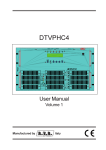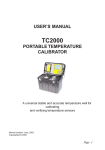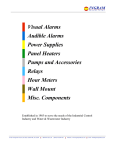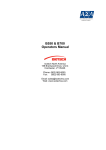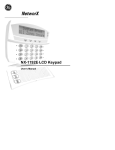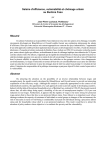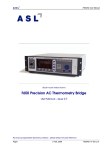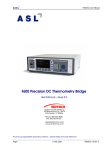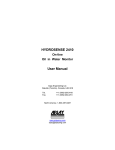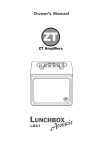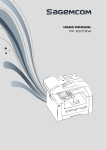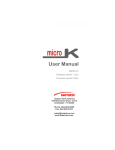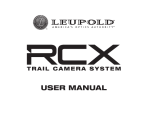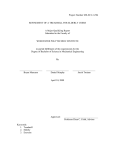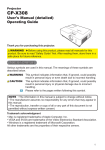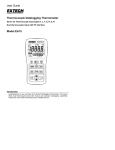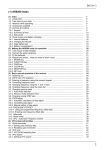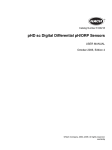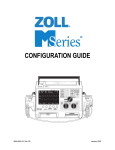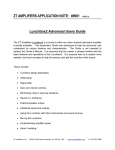Download F100 Precision Handheld Thermometer
Transcript
F100 Precision Handheld Thermometer User Manual Isotech North America 158 Brentwood Drive, Unit 4 Colchester, VT 05446 Phone: (802) 863-8050 Fax: (802) 863-8125 Email: [email protected] Web: www.isotechna.com Page 1-1 F100-14-001.2 ASL 2005 Setting up the F100 th Revision history: Original version 9 September 2005 Previous releases: Issue 1. August 2005 Issue and date Description of change Issue 2 - 10/12/05 Manual updated to reflect changes to the structure of the menu system and different screen layouts. Battery pack insertion and removal information added. Page 1-2 F200-14-001.2 ASL 2005 Setting up the F100 1. Table of Contents 1. TABLE OF CONTENTS ...........................................................................................................................1-3 CONVENTIONS USED IN THIS MANUAL .......................................................................................................1-5 Structure of manual ...........................................................................................................................................1-5 Terminology .......................................................................................................................................................1-5 Warnings and Notices .......................................................................................................................................1-5 IMPORTANT SAFETY INFORMATION............................................................................................................1-6 IMPORTANT BATTERY CHARGER SAFETY INFORMATION ......................................................................1-8 IMPORTANT PROBE SAFETY INFORMATION..............................................................................................1-9 1.0 INTRODUCTION .......................................................................................................................................1-11 1.1 Overview.............................................................................................................................................1-11 1.2 Definitions and Terminology ...............................................................................................................1-11 1.3 Principles of measurement .................................................................................................................1-12 2. 2.1 2.2 SETTING UP THE F100 .........................................................................................................................2-13 Safety information...............................................................................................................................2-13 Unpacking the instrument...................................................................................................................2-13 3. ABOUT THE F100....................................................................................................................................3-1 3.1 The Front Panel ....................................................................................................................................3-1 3.2 About the display screen ......................................................................................................................3-1 3.3 The Keypad ..........................................................................................................................................3-1 3.3.1 Keypad overview ..............................................................................................................................3-2 3.4 F100 thermometer inputs .....................................................................................................................3-3 3.5 Battery Pack .........................................................................................................................................3-5 3.5.1 Removing and replacing the battery pack ........................................................................................3-5 3.5.2 Battery charger.................................................................................................................................3-5 3.5.3 Name plate(s)...................................................................................................................................3-7 3.5.4 USB Communication interface connector ........................................................................................3-7 4. OPERATING THE F100 ...........................................................................................................................4-1 4.1 Instrument operating modes.................................................................................................................4-1 4.1.1 Measurement Mode .........................................................................................................................4-1 4.1.2 Menu Mode ( key)..........................................................................................................................4-2 4.1.3 Other menu options..........................................................................................................................4-5 4.1.4 Setting up Temperature measurement...........................................................................................4-19 4.1.5 Smart Probe review........................................................................................................................4-19 5. 5.1 5.2 INSTRUMENT MEASUREMENT RANGE ...............................................................................................5-1 Instrument measurement working range..............................................................................................5-1 Measurement Ranges ..........................................................................................................................5-1 Page 1-3 F100-14-001.2 ASL 2005 Setting up the F100 6. 6.1 6.2 6.3 6.4 6.5 SMART PROBES..................................................................................................................................... 6-1 About Smart Probes ............................................................................................................................. 6-1 How Smart Probes Work ..................................................................................................................... 6-1 Smart Probe Data Security................................................................................................................... 6-1 Smart Probe Calibration Supervisor..................................................................................................... 6-1 Smart Probe Working Range Monitor .................................................................................................. 6-1 7. 7.1 7.2 7.3 CALIBRATING THE F100........................................................................................................................ 7-1 F100 Instrument calibration.................................................................................................................. 7-1 Equipment ............................................................................................................................................ 7-1 Calibration procedure ........................................................................................................................... 7-1 8. COMMUNICATIONS INTERFACE .......................................................................................................... 8-1 8.1 Introduction........................................................................................................................................... 8-1 8.2 Overview of the USB Interface ............................................................................................................. 8-1 8.2.1 Talk only mode................................................................................................................................. 8-1 8.2.2 ULOG interface ................................................................................................................................ 8-1 9. 9.1 10. 10.1 10.2 10.3 10.4 10.5 OPTIONS AND ACCESSORIES.............................................................................................................. 9-3 Accessories .......................................................................................................................................... 9-3 SPECIFICATION................................................................................................................................ 10-1 Resistance thermometer measurement............................................................................................. 10-1 Display................................................................................................................................................ 10-1 Supply................................................................................................................................................. 10-1 Environmental .................................................................................................................................... 10-2 Dimensions and weight ...................................................................................................................... 10-2 11. CLEANING AND MAINTENANCE .................................................................................................... 11-1 11.1 Cleaning .................................................................................................................................................. 11-1 12. 12.1 SERVICE AND WARRANTY ............................................................................................................. 12-1 Technical Support .............................................................................................................................. 12-1 Page 1-4 F200-14-001.2 ASL 2005 Setting up the F100 Conventions used in this manual Structure of manual The manual is divided into sections. Each section deals with a specific topic or related topics. Sections are displayed in a regular, bold typeface, for example - 1.0 Introduction. Sections are sub-divided into sub-headings, for example - 1.1 Features. These may also be subdivided in turn. Terminology The terms Precision thermometer, thermometer, F100 and instrument are used interchangeably in this manual. Warnings and Notices These appear in the body of the text, clearly displayed with a box surrounding the text. The first word within the box displays the type - Warning or Note. A Warning (double box) is designed to draw attention to an aspect that may cause danger to the user or damage to the instrument. A Note (single box) is used to bring special attention to something important requiring action or avoidance. Copyright © 2005-2006 ASL. All rights reserved. Information in this document is subject to change without notice. Reproduction or modification of the whole or any part of this document (in any form) without Sheens’ written permission is forbidden (except for internal use by an authorised dealer or agent). Customers may make copies for internal use only. Whilst efforts have been made to ensure the accuracy of information presented here, Sheen can assume no responsibility for the accuracy of any information presented or the consequences of acting on this information. Sheen also disclaims any representation that the contents are current. However, Sheen would be grateful for any comments on the layout, accuracy or contents of this manual. Sheen shall not be liable for problems or damages arising from the use (or misuse) of items, servicing, equipment, procedures or options supplied by other companies. ASL. 275 King Henry’s Drive, New Addington, Croydon, Surrey, CR0 0AE, U.K. Tel (+44) (0) 1689 800799. Fax (+44) (0)1689 800405. email [email protected] Page 1-5 F100-14-001.2 ASL 2005 Setting up the F100 Important safety information Read and understand the user instruction manual before attempting to use the instrument. The F100 is a handheld, battery operated, thermometer. It must not be used for any other purpose. Warning The protection provided by the instrument may be impaired if the equipment is not used in the manner specified. Only replace items or components with an approved or equivalent spare part. All spare and consumable parts are available from ASL. Warning The instrument is NOT designed to be used in an explosive atmosphere. Warning The instrument is NOT designed to be used in medical environment 8 Do NOT use the instrument near water or in damp conditions 8 Do NOT clean the instrument with solvents 8 Do NOT insert objects into openings 8 Do NOT place the instrument, battery-pack or charger onto a hot or cold surface 8 Do NOT place any weight on top of the instrument, battery-pack or charger 9Do ensure air can freely circulate around the battery compartment and power-supply during charging 9Do use the correct USB lead supplied Warning Do NOT open the case. There are no user serviceable parts inside. Page 1-6 F200-14-001.2 ASL 2005 Setting up the F100 Warning Inspect cables and probes regularly, ensuring that their insulation is not damaged Warning The instrument and batteries must be disposed of in accordance with local regulations. Please refer to ASL if the instrument is to be disposed of within the European Union. General warning symbol. This indicates that a hazardous condition or general danger may exist. You must read the relevant sections in the User Manual Handbook before operating the instrument. Page 1-7 F100-14-001.2 ASL 2005 Setting up the F100 Important battery charger safety information The battery charger and battery pack are supplied for use with the F100. Warning Only use the battery charger supplied. Use of any other charger will invalidate the warranty and may lead to the danger of overheating and to permanent instrument damage. The battery charger supplied must NOT be used with other equipment. Warning Do NOT cover the battery charger, battery pack or instrument during charging. Ensure air is free to circulate around these items during charging. Warning Do NOT short the contacts on the battery compartment with any metallic object. Page 1-8 F200-14-001.2 ASL 2005 Setting up the F100 Important Probe safety information Care must be taken with probes used with the instrument. The following safety information must be observed. 8 Do NOT lift the F100 by any of the leads 9 Do ensure that long probe-leads are kept away from areas where people could trip over them or become tangled in them 9 Do ensure the probe-leads are kept in good condition Warning Because of the nature of the instrument, probes can be excessively HOT or COLD during use. Take suitable precautionary measures when handling probes. Take care that you (and other people working in the same area) do not come into contact with the metallic probe or the insulating sheath near the probe, which will also be hot/cold. Precautions apply both during use or when moving the probe from one position to another. Warning Probes may be immersed in various chemicals during use. Some of these chemicals may be dangerous or harmful (even when the probe is cold). Always assume that the probe has been used this way and DO NOT touch the probe without suitable protective clothing. Page 1-9 F100-14-001.2 ASL 2005 Setting up the F100 This page is intentionally left blank Page 1-10 F200-14-001.2 ASL 2005 Setting up the F100 1.0 Introduction 1.1 Overview The F100 Precision Handheld Thermometer is a highly accurate instrument designed for laboratory, commercial and industrial temperature measurement and calibration applications. Features include: • Two input channels • A large graphic LCD display for excellent viewing of temperature measurement values and instrument settings • USB communication interface as standard for automated monitoring and calibration applications • Calibration against traceable external standards The F100 will operate with all 4-wire Pt100 (100 ohm) Platinum Resistance Thermometers (PRTs) and with virtually all NTC thermistors. Temperature measurement units are user-selectable and can display °C, °F, K and Ω. Overall system accuracy will depend on the sensor quality and calibration - see the specification section. 1.2 Definitions and Terminology i. 0°C = 273.15 K ii. 1 mK (milli-Kelvin) = 0.001°C (one milli-degree Celsius) iii. 1 milli-degree C = 0.001 °C = 1m°C = 1mK = 1.8m°F iv. 1 milli-degree F = 0.001°F = 1m°F = 0.56mK = 0.56m°C v. Alpha, or α, is the temperature coefficient, or temperature sensitivity, of the platinum wire used in PRTs. In general, the greater the alpha value, the better the PRT thermometer measurement reproducibility, stability and performance vi. Abbreviations for platinum resistance thermometers include PRT (Platinum Resistance Thermometer) Pt100 (PRT with nominally 100Ω resistance at 0°C) RTD (Resistance Temperature Device) vii. NTC is an abbreviation for Negative Temperature Coefficient thermistors viii. System accuracy refers to the overall, combined accuracy of the F100 and thermometer. Page 1-11 F100-14-001.2 ASL 2005 Setting up the F100 1.3 Principles of measurement The F100 measures the voltage (Vt) developed across the unknown sensor resistance (Rt) and the voltage (Vs) across a stable internal reference resistance (Rs). The voltages are proportional to the resistances so the thermometer resistance is derived from – Rt = Rs × Vt Vs This technique achieves immunity from slow moving time and temperature drifts in the electronics, as it is not affected by voltage measurement gain variations or current source fluctuations. In the same way that AC resistance measurement eliminates thermal EMFs, switched DC achieves a similar advantage. Switched DC works by reversing the current flow on alternate measurement cycles and taking the average value, thereby minimising any thermal EMF offsets from the measurement. For PRTs, the relationship between resistance and temperature varies slightly from one PRT to another. Therefore, no matter how accurately the F100 measures the PRT resistance, if the relationship between resistance and temperature for a particular PRT is not known, accurate temperature measurement is not possible. For thermistors, the relationship depends totally on the thermistor type and specifications. The F100 uses PRT and thermistor calibration data to overcome this problem and calculates the result from temperature conversion functions stored in either the sensors ‘SMART’ connector or the F100’s internal non-volatile memory. This method enables the F100 to convert resistance to temperature, uniquely for each sensor used. It is very important, therefore, that a sensor without a ‘SMART’ connector is used on a properly configured input channel and that the probes’ coefficients are correctly entered into the instrument. Note For non-Smart probes, always check that the coefficients are correct set for the probe being used. Failure to do so, may lead to incorrect measurements. System accuracy is a combination of the F100 accuracy in measuring sensor resistance and the calibration uncertainty placed on PRTs and thermistors by the calibrating laboratory. Page 1-12 F200-14-001.2 ASL 2005 Setting up the F100 2. Setting up the F100 2.1 Safety information • Please read the safety information section before attempting to operate the F100 located on page 1.6 onwards. 2.2 Unpacking the instrument When you unpack the F100 thermometer, check that the following items are present before using the 1 instrument - • F100 precision thermometer • Battery charger • Operator’s handbook on CD • Calibration certificate • USB lead • Thermometer probes (if ordered) will be packed separately Please contact the ASL Technical Services Group immediately if any of these items are missing or damaged. Please retain the packaging. In case of return, servicing or calibration, use the original packaging. Failure to do so may invalidate the warranty and/or incur additional costs outside the warranty period. Please contact your agent when the original packaging is unavailable. 1 Thermometer probes (if ordered), will be supplied separately Page 2-13 F100-14-001.2 ASL 2005 Setting up the F100 This page is intentionally left blank Page 2-14 F200-14-001.2 ASL 2005 3. About the F100 This section will introduce you to the features and functions of the F100 Precision Thermometer. Each of the features is explained in turn. Once the F100 has been set-up to your particular requirements, all the commonly used functions are available using single key-strokes. 3.1 The Front Panel LCD display Inputs at rear Keypad USB connector Figure 3.1- Front panel 3.2 About the display screen The large graphic LCD screen is your direct link to the instrument, presenting you with the measurement results and information or menus to set and control the instrument. The LCD screen is designed for reflective-viewing under normal ambient lighting; a backlight is provided for use when ambient conditions are darker. 3.3 The Keypad The F100 keypad is shown below. The keys are used to select the various menu options. Generally, no more than two menu levels are used. A few (infrequently used options) require three menu levels. Operation is simple once you are familiar with instrument. It may help to have the instrument to hand when reading through these sections. Refer to section 4 for a detailed description of how to use the keys to operate the instrument Page 3-1 F100-14-001.2 ASL 2005 Setting up the F100 ΑΣΛ AUTOMATIC SYSTEMS LABORATORIES Ö S X W T Æ A/B 0 5 Key Ö S T W X Æ A/B 0 5 Function Menu display Backlight Up arrow Down arrow Left arrow Right arrow Clear (view statistics) Enter Channel and differential select Zero (offset) reading Hold reading Power on/off ) ) Figure 3.3 – F100 Keypad 3.3.1 Keypad overview 2 The red Power (5 5 ) key turns power on and off to the F100. The F100 uses a menu system. The Menu ( ) key is located at the top right of keypad. Use the Menu key to access to the less frequently used F100 functions. The four Arrow ( S T W X ) keys are used to navigate through the menus; the Enter ( ) and Clear ( Æ ) keys are used to act on the 3 menu selections . The Backlight (Ö Ö) key located at the top left of the keypad provides LCD illumination when the ambient light-level is too low for normal viewing. The A/B key is used to select one of the two channels (A or B) or the difference (A – B) The Zero ( 0 ) key is used to provide relative (offset) readings. The Hold ( ) key is used to freeze the current reading. 2 The F100 may also be set to power-off after a preset period. 3 The Clear ( Æ ) key is also used to view F100 statistics; press once to select the statistics page. Press any key to return. Page 3-2 F100-14-001.2 ASL 2005 Setting up the F100 3.4 F100 thermometer inputs There are two input channels; two 5 pin DIN input-sockets are located at the rear of the instrument. These are designed to take either PRT or thermistor probes. Channel A is colour-coded red. Channel B is colour-coded blue. Channel A (red) Channel B (blue) Figure 3.4 - Rear panel Either channel can accept either Smart or Passive probes; any combination of probes can be use together. Smart probes (described in section 6.0) contain their own calibration information and communicate this to the F100 as soon as they are used. Passive probes do not contain calibration information and the F100 must be set-up with the calibration information for each probe used (and each time the probe is changed). 4 Probe connection information for both PRTs and thermistors is shown below (viewed looking towards the sockets) - PRT or thermistor Figure 3.4.1 4 4-Wire SMART probe PRT/thermistor input Two wire PRTs/thermistors must have the probe pins1 & 2 connected together and also pins 4 & 5 connected together. Page 3-3 F100-14-001.2 ASL 2005 Setting up the F100 PRT or thermistor Figure 3.4.2 4-Wire Passive probe PRT/thermistor input Page 3-4 F100-14-001.2 ASL 2005 Setting up the F100 3.5 Battery Pack USB communications connector Battery pack, removed from the F100 Battery charger input connector Figure 3.5 - Base of the F100 showing the battery back removed The instrument operates from battery power (or from a powered USB cable when connected to a PC). The battery pack is replaceable. 3.5.1 Removing and replacing the battery pack To remove the battery pack, press the latching tab and slide the battery pack back. See figure 3.6 for details. Figure 3.6 – Removing and replacing the battery pack To replace the battery pack, place the pack in position before sliding home. See figure 3.6 for details. Do check that the battery pack is securely in position before using the instrument. 3.5.2 Battery charger Page 3-5 F100-14-001.2 ASL 2005 Setting up the F100 The batteries are located in a removable pack located on the base of the instrument. The batteries may be charged in-situ or the battery pack may be removed and recharged separately (spare battery packs are available). Refer to page 1.8 for additional safety information. Note Batteries are shipped fully discharged. The battery pack should be fully charged before first-use. It is shipped fully discharged. The battery pack contains two NiMHi cells in series and a charger control circuit. The battery pack must only be charged using the unit supplied. Warning Only use the battery charger supplied. Use of any other charger will invalidate the warranty and may lead to the danger of overheating and to permanent instrument damage. The battery pack has a socket on its side that accepts the chargers’ connector. The F100 may be used when the battery pack is being charged, but its performance may be degraded. Note It is recommended that the battery pack is removed from the F100 for charging. Check that the small LED visible through the bottom of the battery pack flashes during charging. Flashing ceases when the battery is fully charged. Warning Take care not to short the battery packs’ contacts with any metal object when the pack is not connected to the instrument. Warning Take care not trap any part of your hand when closing the battery compartment. The AC battery charger provides various interchangeable mains connectors; select the one that you require - see the charger pack for details. Page 3-6 F100-14-001.2 ASL 2005 Setting up the F100 Note Disconnect the charger when not in use. 3.5.3 Name plate(s) The instrument rating plate shows the instruments maximum power consumption and instrument serial number. The label on the battery charger shows its AC voltage range and operating supply frequency and current. 3.5.4 USB Communication interface connector The USB connector is fitted as standard (see figure 3.5). Communication requires the installation of the USB driver on a PC; see the separate information supplied on the CD. A standard USB cable is supplied with the F100. The instrument can be used with ASL’s ULOG program (supplied on the CD) or simply used to transmit ASCII data, which may be recorded using a simple terminal program. The F100 is designed to work with power supplied by a USB connector that is suitably supported by a PC. Note The power supplied by a USB cable connected to a PC may be noisy. ASL can accept no responsibility for any performance degradation for a F100 connected or powered this way. Page 3-7 F100-14-001.2 ASL 2005 Setting up the F100 This page is intentionally left blank Page 3-8 F100-14-001.2 ASL 2005 Operating the F100 4. Operating the F100 4.1 Instrument operating modes The instrument has two operating modes • Measurement Mode that displays the measurement readings and status information • Menu Mode that lets you select and alter the instrument operation and its settings 4.1.1 Measurement Mode In Measurement Mode, the LCD displays the current reading (temperature or resistance), the unit symbol, the channel and type of sensor selected (and conversion method); the time of day is also 5 shown . This is the normal operating display for the F100. The display will look similar to the one shown below – Smart probe serial number (if one attached) Channel (ChA) using a 4 wire sensor (PRT4) &K$ V) 357 Probe conversion R& R& ,76 ,76 Current reading with units displayed below Reading units Time of day This display always reflect the operation of the instrument, showing the current reading(s) and settings. Readings are updated at the normal conversion rate of one every two seconds. 5 The time text will be replaced by ‘Logging’ or ‘Remote’ when these modes are selected Page 4-1 F100-14-001.2 ASL 2005 Operating the F100 4.1.2 Menu Mode ( key) In menu mode, the LCD displays the various options available to control F100 operation. Press the Menu key ( ) to select the menu screen. 8QLWV &KDQQHO$ &KDQQHO% /RJJLQJ 6WDWLVWLFV 6HWWLQJV 6\VWHP Current menu highlighted The (highlighted) reverse-video background shows the menu item that will be selected when the Enter key ( ) is pressed (Units selection in the example above). Further menu options may follow once the Enter key is pressed. Press the Up ( S ) and Down ( T ) keys to move through the options. Pressing an up/down key will move the reverse 6 video selection one line up or down one line . Once the selection is correct, press the Enter key. So, for example, to change channel A options, press the Down key ( T ) once 8QLWV &KDQQHO$ &KDQQHO% /RJJLQJ 6WDWLVWLFV 6HWWLQJV 6\VWHP to obtain the display shown. Now press the Enter key once ( ) to select this option. The following screen will appear (when a Smart probe is connected to channel A). The display will be different if a passive probe is attached instead. Press the Down key ( T ) once to obtain this display. The SMP Probe Info line will be highlighted. Now that this menu has been highlighted, press the Enter key ( ) once to obtain the display shown. The selection moves down one line and the SMP Coefficients line will 6033UREH,QIR 603&RHIILFLHQWV 6 03 3UR EH,QIR 6 03 &RH IILFLHQ WV be highlighted. 6 The selection line will wrap round from top to bottom (or bottom to top) on repeated arrow presses. Page 4-2 F100-14-001.2 ASL 2005 Operating the F100 In this example, pressing the Up or Down key will display more of the Smart probes’ coefficients. Press the Clear key ( Æ ) to return the display to the previous menu. Press the Clear key ( Æ ) once more to return to Measurement Mode. Alternatively, press the Enter key ( &K$V&9' 5H $H %H 5HDG2QO\ 8S'RZQ 0RYH &OHDU ([LW ) to return the F100 immediately to Measurement Mode ( these actions generally applies to all lower level menu options). No changes can be made in this example. When changes are made, all settings are stored and retained when power is removed. 4.1.2.1 Selecting the thermometer input channel and differential mode (A/B key) The channel Select key ( A/B ) is used to change between channels and also to select the differential operational mode, ( A – B ). The channel selection order is – Channel A Î Channel B Î Channel (A – B) Î Channel A A missing (or faulty) probe will be indicated on the display by a series of dashed lines. In differential mode (when both channel A and channel B have probes connected), the screen will look similar to the following example. The asterisk next to the ChA and ChB legends will alternate as readings are updated. Differential mode indicator Probe conversion for current channel &K$ &K% Individual channels readings &9' R& R& R& PRYH The probe conversion indicator (bottom-left) displays the conversion method for the current reading (and so will alternate if the two channels have different conversion methods). 4.1.2.2 Selecting relative temperature measurement (0 key) The instrument displays a reading value relative to a fixed offset in Zero (or relative) mode. Press the Zero ( 0 ) key to select this mode. Page 4-3 F100-14-001.2 ASL 2005 Operating the F100 In Zero mode, the instrument stores the last reading (at the time of Zero key press) and subtracts it from all subsequent readings. It continues to do this until it is either cancelled (by pressing the Zero key again) or until power is removed. &K$ V) 357 Zero offset value Absolute value (flashing) R& R& 2IIVHW 2IIVHW Zero mode indication alternates with the conversion method Zero mode also works on differential measurements (A – B). In this case, both channels values are frozen at the time the key is pressed. The absolute value, in the example above, is replaced by the relative difference value. To cancel the relative measurement mode, press the Zero ( 0 ) key again. Zero mode is cancelled when power is turned off. 4.1.2.3 Selecting run/hold mode () Instrument measurements stop completely when Hold mode is active. This is indicated on the bottomleft of the display where Hold mode indication alternates with the current conversion method, providing a flashing indication. Hold mode may be used when the F100 is in differential mode. &K$ V) 357 Hold mode indication alternates with the conversion R& R& +ROG +ROG Press the Hold ( ) key to alternate between run and hold modes. Hold mode is cancelled when power is turned off. 4.1.2.4 Backlight key (Ö Ö) The backlight is designed to be used for viewing the display in low ambient light levels. Press the Backlight key (Ö Ö) to illuminate the display. Once on, the backlight will automatically go off after about 10 seconds (alternatively, press the Backlight key again to turn it off). Page 4-4 F100-14-001.2 ASL 2005 Operating the F100 Note Using the backlight will dramatically reduce battery life (by about 30% if used continually at full-brightness). The brightness level can be set on the Settings menu (see later section). Reducing the brightness value will increase battery life when the backlight is used. 4.1.3 Other menu options This section describes the other options available through menu selection. Generally, these options are set once and altered rarely. The set-up is stored in non-volatile memory and recalled when power is reapplied. In the following sections, the top level menu is shown, followed by the sub-menu(s) that it selects. 4.1.3.1 Selecting Units Press the Menu key ( ) to change the measurement units. The Units menu will be highlighted. Press the Enter key once to reach the Units selection menu. 8QLWV &KDQQHO$ &KDQQHO% /RJJLQJ 6WDWLVWLFV 6HWWLQJV 6\VWHP &HOVLXV )DKUHQKHLW .HOYLQ 2KPV Select the units required with the Up/Down keys and then press the Enter key. Units of Celsius (°C), Fahrenheit (°F), Kelvin (K) or Resistance (Ω) can be selected; the current units are shown on the Measurement Menu screen. Changing units will automatically clear any statistics. The current measurement units are retained when power is removed. Having selected the new units, press the Menu key to return to Measurement Mode. 4.1.3.2 Channel options menu (Channel A or Channel B) – Smart probes When Smart probes are used, the calibration data is stored in the probe; the coefficients held in the F100 are not required or used. Page 4-5 F100-14-001.2 ASL 2005 Operating the F100 Note Smart probes use their own internal calibration data. The instrument coefficients are ignored when a Smart probe is attached. Only channel A operation will be covered (channel A and channel B operate identically). Press the Enter key to select the sub-menu. Note that the sub-menu will be different for Smart and Passive probes. The Channel sub-menu is used to review the information about the Smart Probe and to review the coefficients used by the Smart probe. 8QLWV &KDQQHO$ &KDQQHO% /RJJLQJ 6WDWLVWLFV 6HWWLQJV 6\VWHP 6033UREH,QIR 603&RHIILFLHQWV Press the Enter key to select Smart probe >$@603 9HU /RFN 7\SH357 :LUH &RQY',1 8S'Q 3UY1[W information. The display will look similar to the one shown. The values held by the Smart probe are displayed. Use the Up/Dn keys to display more of the values held within the probe. Refer to the section on Smart probes for further details; the SMP Coefficient Menu is covered in section 4.1.2. 4.1.3.3 Channel options menu (Channel A or Channel B) – Passive probes Only channel A operation will be covered (channel A and channel B operate identically). Press the Enter key to select the sub-menu. Note that the sub-menu will be different for Passive and Smartprobes. The Channel sub-menu is used to change the information about the Passive probe. Page 4-6 F100-14-001.2 ASL 2005 Operating the F100 8QLWV &KDQQHO$ &KDQQHO% /RJJLQJ 6WDWLVWLFV 6HWWLQJV 6\VWHP 3UREH7\SH 7HPS&RQY &RHIILFLHQWV Press the Enter key to select Probe Type. A Passcode screen will appear (see below). A pass-code must now be entered to proceed any further (since altering the probe-type or 3DVVFRGH /HIW5W6HOHFWV 8S'RZQ&KDQJHV (QWHU 2. other probe information may lead to the display of totally incorrect values). Use the Up/Down arrow keys to increment or 7 decrement the digit highlighted by the cursor . Use the Left/Right keys to mover to the next digit and use the Enter key once the correct pass-code has been set; this procedure helps to prevent 8 inadvertent changes. Once the code has been entered, it will remain valid until power is turned off . 4300 The pass-code for Passive probe entry is Once this code has been correctly entered, the following screen will appear. There are two completely different probe types that can be used with the F100 - i.e. PRT or 357:LUH 17&7KHUPLVWRU Thermistor. The probe sub-menu is used to select between these two probe types (this only applies to passive probes). The currently selected sensor type is always shown at the top left of the measurement screen (see the example shown in section 4.1.1). For example, use the Down key to highlight the thermistor probe. If this probe-type is then selected (using the Enter key), the thermistor line will be highlighted instead when the menu is entered again. Selection of PRTs is more involved since the conversion method must also be set at the same time as the probe-type is changed. The Temp Conv (Temperature Conversion) menu allows the conversion mode to be set for the currently selected probe. 7 The values will wrap from 9 to 0 and from 0 to 9 8 The valid pass-code will have to be entered once any of the three menu-items is selected for the first time. Page 4-7 F100-14-001.2 ASL 2005 Operating the F100 8QLWV &KDQQHO$ &KDQQHO% /RJJLQJ 6WDWLVWLFV 6HWWLQJV 6\VWHP This screen shows that 3UREH7\SH 7HPS&RQY &RHIILFLHQWV the ',1 &9' ,76 DIN conversion method is currently selected for this channel. Use the Up and Down keys to highlight the required conversion method, and then use the Enter key to select it. For PRTs, the instrument provides three standard algorithms for converting resistance to temperature. The choice of algorithm depends on the PRT type and its calibration – • DIN (1992) - used for un-calibrated industrial PRTs with 0.00385 ‘alpha’ value, to provide a conversion of resistance to temperature in accordance with BS EN60751 (ITS 90) standard • CVD coefficients - Callendar van Dusen used for calibrated industrial or low alpha PRT’s of 0.00385 • ITS-90 coefficients - used for calibrated high alpha PRT’s of values 0.003926 to 0.003928 For Thermistors, the instrument provides one standard algorithms for converting resistance to temperature – • Steinhart and Hart Both PRT and Thermistor probes must be correctly calibrated to provide their most accurate performance. The F100 can store calibration data for each of the two channels (only required when passive probes are being used). For Passive-probe PRTs, the coefficients are set from this sub-menu. Page 4-8 F100-14-001.2 ASL 2005 Operating the F100 8QLWV &KDQQHO$ &KDQQHO% /RJJLQJ 6WDWLVWLFV 6HWWLQJV 6\VWHP 3UREH7\SH 7HPS&RQY &RHIILFLHQWV In this example, the edit screen for CVD &K$&9' 5H $H %H 8S'RZQ 0RYH (QWHU (GLW &OHDU ([LW coefficients is shown; the first character (R) will be highlighted. The screen is still in Review Mode (this is the only mode for DIN conversion probes). Note The parameters are always fixed for DIN probes and cannot be changed. In Review Mode, the R of the R0 coefficient will be highlighted. Press the Enter key to change to Edit Mode. The display will now look similar to the one shown (note that the text on the top line has changed to Edit). The first character of the coefficient will be highlighted (in this case the ‘+’). This is the current cursor position. Use the Up and Down keys to change from ‘+’ to ‘-‘ and (GLW 5H $H %H /HIW5W6HOHFWV 8S'RZQ &KDQJHV (QWHU 6DYHV back again (as required). Once the digit value is correct, use the Left or Right key to select the next digit to be set. Use the Enter key once the complete coefficient has been edited correctly; alternatively use the Clear key to abandon editing and move back to the previous menu. The coefficients will be set to the value shown when the 9 Enter key is pressed . Once the first coefficient has been edited and accepted, the screen will scroll (if more than three coefficients are required). For example, after entering R0, the following screen will appear. 9 Data entry is very similar for thermistor coefficients. Page 4-9 F100-14-001.2 ASL 2005 Operating the F100 &K$',1 $H %H &H 8S'RZQ 0RYH (QWHU (GLW &OHDU ([LW 4.1.3.4 Data logging menu The F100 can log data. Logging status (when the log is on) is always shown on the bottom right-hand corner of the measurement screen (see section 4.1.1). The instrument is capable of logging a maximum of 8000 data points. The currently selected channel is logged, i.e. channel A, channel B, or the difference (A – B); the currently selected conditions are used. The logging interval may be set so the length of time spent logging can be varied. There are a finite number of data points that can be stored, eventually the log will become full and logging will cease. Logging is cumulative, so that when logging is restarted (after a previous session), the log continues from the previous point to the end (clear the log if you do not need the previous data points). Press the Enter key to select the menu for the various logging options. The exact screen display depends on the current logging-status (this example shows the screen displayed when the F100 is not logging). 8QLWV &KDQQHO$ &KDQQHO% /RJJLQJ 6WDWLVWLFV 6HWWLQJV 6\VWHP 6WDUW 6HWXS 5HYLHZ &OHDU Data can be viewed, logged at regular intervals (the interval must be set before Start is selected) and logging can be turned on or off. Logging is started with the Start menu. The Set-up menu is used to set the current logging interval. The previously logged values can be looked at when the Review menu is selected. The Clear menu is used to set the clear the log. Press the Enter key to select the various logging options. Page 4-10 F100-14-001.2 ASL 2005 Operating the F100 8QLWV &KDQQHO$ &KDQQHO% /RJJLQJ 6WDWLVWLFV 6HWWLQJV 6\VWHP a) 6WDUW 6HWXS 5HYLHZ &OHDU Start Log Selecting this menu option will immediately start logging. Next time the logging menu is selected (once logging has started), the menu will change to the one shown. Only two options are available now. Logging 6WRS 5HYLHZ will continue in the background, so the only options available are to Stop logging and to Review the log. b) Setup Use this menu item to set the logging interval; points will then be logged at this interval. Any time interval between [2 seconds] and [59 minutes 59 seconds] can be used. The example below is set for logging to take place every 5 minutes (the hour values are not active for logging interval setting). 6WDUW 6HWXS 5HYLHZ &OHDU +LVWRU\6HWXS PPVV ,QWYO Set a time interval to match your requirements. Logging at slower data intervals effectively increases the total period for which data can be logged. Either select the required interval with the Enter key or use the Clear key to return to the Measurement Menu. c) Review Selecting this option will display the Review menu. A message will be displayed if there are no results in the log. Page 4-11 F100-14-001.2 ASL 2005 Operating the F100 6WDUW 6HWXS 5HYLHZ &OHDU Start hour for this page Time of this reading Channel )HE $ & $ & $ & $ & $ & $ & 'Q 1H[W3J Page number Units Reading The log shown has 230 results (for channel A in units of °C, logged every 2 seconds ). Use the Down key to scroll through the logged readings, one page at a time. Press the Clear key ( Æ ) to return to the logging menu (pressing the clear key again will return to the Measurement Menu. Logging ceases at power-off. d) Clear Selecting this option will clear the log immediately and return to the previous menu. 4.1.3.5 Statistics menu The F100 provides statistics on the data collected. Statistical information is calculated continuously from the moment statistics are cleared (see submenu). Changing any parameter that affects the calculation (e.g. units) will automatically clear and restart calculation. The display is frozen while the values are viewed, although data collection still continues. 8QLWV &KDQQHO$ &KDQQHO% /RJJLQJ 6WDWLVWLFV 6HWWLQJV 6\VWHP ([LW &OHDU &K$ 0Q 0[ 0HDQ 6WGGHY 7RWDO The Exit option is used to return to the Measurement Menu after viewing statistics. Alternatively, press the Clear key ( Æ ) to return to previous menu without clearing statistics. Page 4-12 F100-14-001.2 ASL 2005 Operating the F100 The minimum, maximum, mean, standard deviation and total number of readings are displayed on this 10 screen . Select Clear to immediately clear and restart the statistical calculations. 4.1.3.6 Settings menu The settings menu allows the various other instrument parameters to be set. a) Brightness Selecting this option allows the brightness of the LCD backlight to be adjusted. Use the Enter key once you are happy with the backlight intensity. Use the Clear key to exit without altering the set value. The current value, set by the Up/Down keys, is shown in the middle of the display (56 in this case); values range from 0 (off) to 100 (full brightness). %ULJKWQHVV 7LPHRXWV 7LPH'DWH $'&0RGH 6HWEULJKWQHVV XVH8S'RZQNH\V $Q\NH\WRH[LW Note Do NOT leave the instrument for any length of time with this menu selection on (it is the only one menu where the backlight is on continuously). Note When the F100 is battery operated, using the backlight will dramatically reduce battery life. The current used increases as the backlight intensity rises. b) Timeouts The F100 can be set to timeout after a preset period (to save battery life); by default the timeout is off. Selecting this option allows the various timeout values to be set. Use the Up and Down keys to select the required timeout and then press the Enter key to select it (or use the Clear key to return to previous menu, or the Menu key to return to the Measurement Menu). 10 Statistical values are also displayed (continuously updated) on the Measurement Menu screen when the clear button is pressed while the F100 is displaying measurements. Page 4-13 F100-14-001.2 ASL 2005 Operating the F100 %ULJKWQHVV 7LPHRXWV 7LPH'DWH $'&0RGH 1RWLPHRXWV PLQXWH PLQXWHV PLQXWHV KRXU KRXU KRXU c) Time & Date menu 11 The F100 contains a real-time clock . The Time & Date menu is used to set the current time and date. The Menu key is used to change the settings. Use the Up and Down keys to alter the value under the reverse-video cursor. Once the correct value is set, use the Right and Left keys to move to the next field. Use the Clear key to exit without changing the values. The Enter key will set the clock to the new values. It is important to set the clock correctly when using data logging. %ULJKWQHVV 7LPHRXWV 7LPHDQG'DWH $'&0RGH $XJ /HIW5W6HOHFWV 8S'RZQ&KDQJHV &OU(QWHU([LWV d) ADC mode menu The F100 has been set to 50 Hz & 60 Hz reject (rejection filter) by default. Select 50 Hz or 60 Hz, depending on the operational mains frequency in your area. This can provide better noise rejection. See the menu screen shown below. Select the appropriate frequency. %ULJKWQHVV 7LPHRXWV 7LPH'DWH $'&0RGH 11 +]5HMHFW +]5HMHFW +]5HMHFW The clock battery is contained inside the instrument case; the battery pack is not used by the real time clock. Page 4-14 F100-14-001.2 ASL 2005 Operating the F100 4.1.3.7 System menu The system menu allows the various other instrument parameters to be set. &KDQJH3DVVFRGH &DOLEUDWLRQ )DFWRU\'HIDXOWV 'LDJQRVWLFV a) Change Passcode Selecting this option allows the F100 System pass-code to be set to another value. The System pass-code is required to reset all the default instrument settings – i.e, all values apart 12 from the instrument calibration itself . The current pass-code has to be entered correctly before a new code can be set. The pass-code for entry to the menu is 5080 Use the Up and Down keys to change the pass-code value. Press Enter when the current pass-code is correct. The new value can then be set. 12 &KDQJH3DVVFRGH &DOLEUDWLRQ )DFWRU\'HIDXOWV 'LDJQRVWLFV 3DVVFRGH /HIW5W6HOHFWV 8S'RZQ&KDQJHV (QWHU 2. 2OG&RGH /HIW5W6HOHFWV 8S'RZQ&KDQJHV (QWHU 2. &XUUHQW $Q\NH\WRH[LW Smart probe values will not be changed; however, Passive probe coefficients will be reset. Page 4-15 F100-14-001.2 ASL 2005 Operating the F100 b) Calibration Selecting this option allows the F100 to be calibrated; this procedure will overwrite and replace the exiting calibration data. The correct equipment, environment and accurately calibrated resistors are required. Note Selecting this option will overwrite the instrument calibration data. Do not attempt to do this unless you have the correct equipment, environment and suitably trained personnel. The procedure is covered in separate documentation and requires a passcode to for entry. c) Reset defaults The instrument parameters can be set to the factory defaults. Selecting this option will overwrite any existing (passive probe) coefficient data and reset the default values for the operational details. To gain access, a pass-codes must be entered first. &KDQJH3DVVFRGH &DOLEUDWLRQ )DFWRU\'HIDXOWV 'LDJQRVWLFV 3DVVFRGH 8S'RZQFKDQJHV (QWHU VHOHFWV &OHDUFRHII·V 5HVWRUHIDFWRU\ 'HIDXOWV" (QWHULI<HV &OHDUIRU1R Note Selecting this option will overwrite all probe calibration data and settings. Do not attempt to do this unless you have the correct equipment, environment and suitably trained personnel. Page 4-16 F100-14-001.2 ASL 2005 Operating the F100 d) Diagnostics menu The last menu is not available without entry of the correct pass-code. Page 4-17 F100-14-001.2 ASL 2005 Operating the F100 This page is intentionally left blank Page 4-18 F100-14-001.2 ASL 2005 Operating the F100 4.1.4 Setting up Temperature measurement To enable accurate resistance to temperature conversion to be carried out by the instrument, PRT or characterisation data is required for both – • temperature conversion algorithm, and • temperature conversion algorithm coefficients For Thermistors, characterisation data is only required for – • temperature conversion algorithm coefficients The data can be stored in either a Smart probe or the instruments’ internal non-volatile memory (Passive probe), each thermometer input channel stores one set of PRT/Thermistor characterisation data. See the relevant section above for details on entering the data. 4.1.4.1 Temperature measurement with Smart probe (s) If a Smart probe is detected on a selected input channel, the PRT calibration data is loaded directly from the Smart probe. Smart probe data always takes precedence over the internal F100 coefficient 13 data (but does not overwrite the instrument data) . 4.1.4.2 Instrument calibration This is not usually a customer option; refer to separate documentation. 4.1.4.3 Firmware Version The firmware version is shown on the LCD when the instrument is first powered. 4.1.5 Smart Probe review The Smart probe data can be viewed, but not changed on the F100. The Smart probe data contains the following information. First LCD screen Ver Smart probe data format version Lock Password protection state 0 = Smart probe data locked can not be changed from the instrument 1 = Smart probe data unlocked can be changed from the instrument 13 Any calibration data entered is retained for future use a Passive probe. Page 4-19 F100-14-001.2 ASL 2005 Operating the F100 Type Probe type PRT or Thermistor Wire Indicates the probe sensor connection details Conv Selected method of resistance to temperature conversion algorithm to use, DIN, ITS90, CvD or Steinhart and Hart (for thermistors) Second LCD Screen Serial No Serial number of the Smart probe Source Company that carried out the Smart probe calibration Third LCD Screen Cal date Date of the Smart probe calibration Due date Date the Smart probe calibration is next due Fourth LCD Screen Min limits Minimum resistance limit for the probe Max limits Maximum resistance limit for the probe Fifth LCD Screen Min since Minimum recorded resistance the Smart probe has been exposed to since it was last calibrated Max since Maximum recorded resistance the Smart probe has been exposed to since it was last calibrated Sixth LCD Screen Min ever Minimum recorded resistance the Smart probe has been exposed to during its working life Max ever Maximum recorded resistance the Smart probe has been exposed to during its working life Page 4-20 F100-14-001.2 ASL 2005 Operating the F100 5. Instrument Measurement Range 5.1 Instrument measurement working range 14 The instrument can detect the following conditions Open Circuit Probe , Over Range measurement and Under Range measurement. These conditions are shown by a line of dashes ‘----------‘ on the LCD display. 357 &K$ R& R& &9' &9' No reading available 5.2 Measurement Ranges Measurement Thermistor Resistance Temperature Measurement Units PRT Resistance Temperature 14 Units Conversion Under Range Over Range Units None 0 400,000 ohms S&H 15 Thermistor dependent °C/°F/K Conversion Under Range Over Range Units None 0 410 ohms Din90 -201 +851 °C/°F/K CvD -201 +850 °C/°F/K ITS90 -201 +963 °C/°F/K Because of the potentially high resistances of thermistors, it may not be possible to determine the difference between connected and disconnected probes for these sensors. 15 Steinhart & Hart Page 5-1 F100-14-001.2 ASL 2005 Operating the F100 6. Smart Probes 6.1 About Smart Probes Smart probes are similar to passive probes except for one key advantage - all the probe details, calibration data and probe history are stored within the probe itself and not within the measurement instrument. Smart probes can be moved freely from channel to channel or instrument to instrument without the need to manually enter any data into the instrument. 6.2 How Smart Probes Work Each Smart probe if fitted with a small non-volatile memory device; this device is transparent during normal temperature measurement. The probe is interrogated before a measurement cycle and the probe data is read into the instrument for use in the measurement process. 6.3 Smart Probe Data Security To maintain a high level of data security, the Smart probe has a built in data-lock. If the data-lock is set, the Smart probe data cannot be modified. 6.4 Smart Probe Calibration Supervisor To assist in maintaining valid calibration, the instrument checks the Smart probe calibration date and compares it with the instruments current date. If the Smart probe date is found to have expired the instrument will warn the user. 6.5 Smart Probe Working Range Monitor The Smart probe working range monitor is used to monitor a Smart probes working range and to notify a user if it is used outside its specified range. Page 6-1 F100-14-001.2 ASL 2005 Operating the F100 7. Calibrating the F100 7.1 F100 Instrument calibration The dc bridge measurement technique used in the F100 is inherently very stable and linear. However some small drift of the internal reference resistor may occur with time, making periodic instrument recalibration advisable. 7.2 Equipment Temperature controlled environment at +20°C ±2°C. Set of stable, calibrated (1ppm) resistors (3 ranges, 6 resistors). 7.3 Calibration procedure See separate documentation. Page 7-1 F100-14-001.2 ASL 2005 Operating the F100 8. Communications Interface 8.1 Introduction The F100 is fitted with USB communication interface as standard. 8.2 Overview of the USB Interface Two modes of operation are available – talk only mode and remote ULOG mode. 8.2.1 Talk only mode Talk only mode can be set On or Off from the Options menu. Talk only mode is useful for outputting data directly to a PC. 8.2.2 ULOG interface Refer to ULOG documentation and software on the CD. Page 8-1 F100-14-001.2 ASL 2005 Options and Accessories This page is intentionally left blank Page 8-2 F100-14-001.2 ASL 2005 Smart Probes 9. Options and Accessories 9.1 Accessories The following options are available for the F100 – Part Number Description F100 Battery Pack Spare battery pack FA-SMART Smart connector FA-DIN5 5-pin DIN plug FA-ADAP-250 Adaptor box to allow connection to spade terminal or free wire terminated PRTs UKAS system calibration at F100-CAL-A -50, 0, +100 & +250°C UKAS system calibration at F100-CAL-B -70, 0, +100 & +450°C FA-SC100 Soft carry case EXT-C Probe extension cable (DIN/DIN) A range of standard probes are available – Order Suffix T100-200-1S T100-200-1S-NAM T100-250-1S T100-250-1S-NAM T100-450-1S T100-450-1S-NAM Description 100 un-calibrated PRT range –50 to +200°C Smart connector 100ҏPRT UKAS calibration at –50 to +200°C Smart connector 100 un-calibrated PRT range –50 to +250°C Smart connector 100ҏPRT UKAS calibration at –50 to +250°C Smart connector 100 un-calibrated PRT range –70 to +450°C Smart connector 100ҏPRT UKAS calibration at –70 to +450°C Smart connector For non-Smart (i.e. Passive probe) versions of the above, substitute a ‘D’ suffix in place of the ‘S’. For example, T100-450-1S-NAM becomes T100-450-1D-NAM if the Smart connector is not required. Page 9-3 F100-14-001.2 ASL 2005 Options and Accessories This page is intentionally left blank Page 9-4 F100-14-001.2 ASL 2005 Operating the F100 10. Specification 10.1 Resistance thermometer measurement PRT characterisation ITS90 Din90 BS EN60751:1996, IEC60751:1983 CvD Thermistor characterisation BSEN1904:1984, IEC751:1983 Steinhart and Hart (NTC) Resistance measurement range (PRT) 1 to 400 ohm Resistance measurement range (Thermistor) 1 to 400,000 ohm Temperature measurement range ITS90 -200 to +962ºC Din90 -200 to +850ºC CvD -150 to +850ºC Thermistor – type dependent Accuracy ± 0.02ºC (20mK) Display resolution 0.001ºC Resistance measurement uncertainty ± 8mΩ ҏ ( + 2 0 °C ±5 °C ) Temperature coefficient (resistance measurement) 0.2ppm/°C (0.05mK/°C) Long term stability (resistance measurement) ± 25ppm (±2.5mΩ ) / year (100 Ω r e f e r e n c e ) Temperature measurement uncertainty Pt100 Over -200 to +800ºC Pt100 sense current 1mA (DC) polarity switchable User selectable measurement display units ºC/ ºF/ K or ohms Input channels PRT or thermistor Input connection 2 x 5 pin DIN Measurement configuration 4 wire Input impedance > 10MΩ Max common and differential mode input voltage ±40VDC, 28Vrms ± 0.01ºC 10.2 Display User interface, display 128 x 64 LCD with (optional) backlight 10.3 Supply Mains charger supply voltage range 90 – 264Vac Power consumption 3VA max Supply frequency range 47 - 63Hz Page 10-1 F100-14-001.2 ASL 2005 Specification 10.4 Environmental Storage temperature range -20ºC to +50ºC Service temperature range 0ºC to +40ºC Specified operating temperature range +15ºC to +25ºC Operating relative humidity conditions <80% RH, non-condensing 10.5 Dimensions and weight Dimensions 232 x 97 x 53 mm (L x W x D) Weight 0.5kg (1.1 lbs) Page 10-2 F100-14-001.2 ASL 2005 Operating the F100 11. Cleaning and Maintenance 11.1 Cleaning Make sure the F100 is disconnected from the mains battery charger before cleaning. Clean the outside of the instrument with a soft, clean cloth, slightly dampened with mild detergent. Do not allow water to enter the instrument. Warning Never use alcohol or thinners as these will damage the instrument. Never use a hard or abrasive cloth or brush. Page 11-1 F100-14-001.2 ASL 2005 Cleaning and Maintenance This page is intentionally left blank. Page 11-2 F100-14-001.2 ASL 2005 12. Service and Warranty F100 equipment and accessories, (unless stated otherwise), are covered by a 12 month warranty on parts and labour from the date of dispatch from ASL. This warranty does not include costs incurred in returning the equipment to the factory for repair. 12.1 Technical Support For all technical support, repair, warranty and service inquiries please contact: Isotech North America 158 Brentwood Drive, Unit 4 Colchester, VT 05446 Phone: (802) 863-8050 Fax: (802) 863-8125 Email: [email protected] Web: www.isotechna.com Page 12-1 F100-14-001.2 ASL 2005

























































